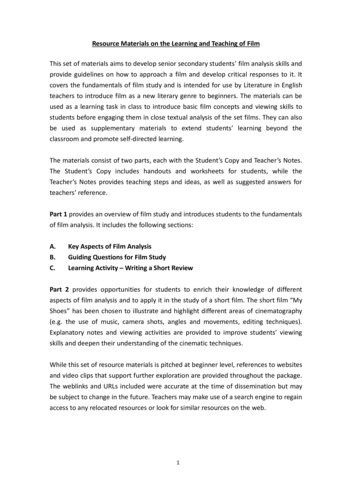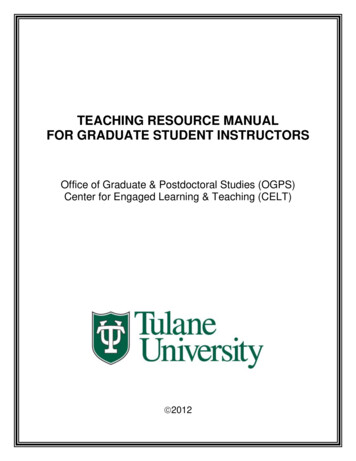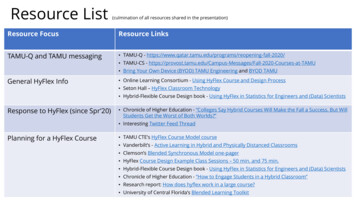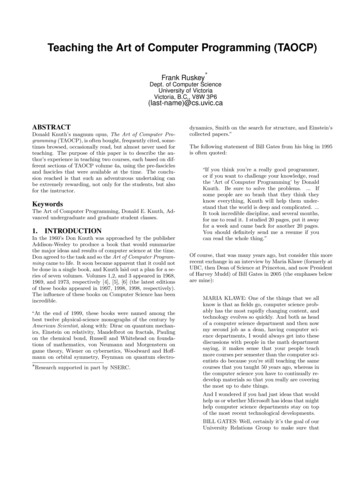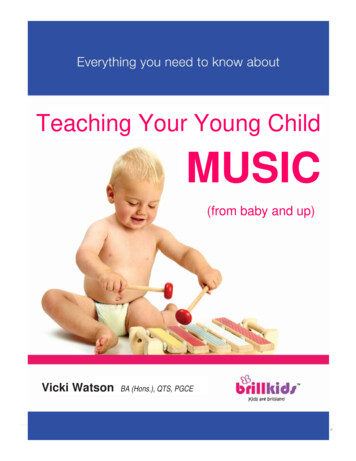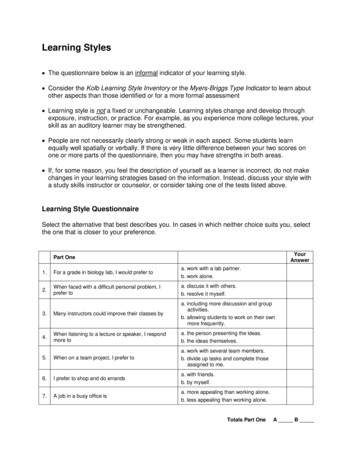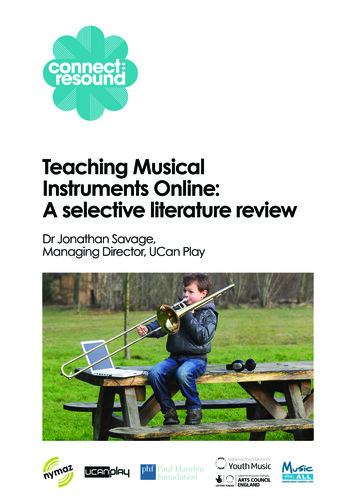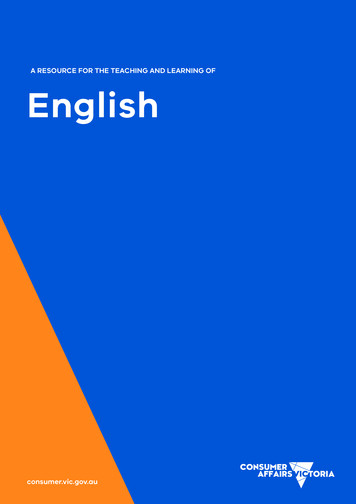
Transcription
A RESOURCE FOR THE TEACHING AND LEARNING OFEnglishconsumer.vic.gov.au
A resource for the teaching and learning ofconsumer affairs victoria1Need consumer help? 1300 55 81 81www.consumer.vic.gov.au
ermissionsPConsumer Affairs Victoria (CAV) would like to thank the following individuals and organisationsfor permission to reproduce copyright material:–––––––––‘The European Schoolboy - advertising in school’ by Ellie Mears and published byThe Federation of German Consumer Organisations on the ‘yomag’ website: www.yomag.org‘The Age’ newspaper for permission to reproduce the following article:‘Boys succumb to image ideal’ by David Rood, 27th March, 2003NSW Office of Fair Trading for excerpts fom A resource for the teaching and learning of EnglishThe Queensland Government for use of materials from the Responsible Gambling Teacher Resource Kit (2004)‘What are the odds: Understanding the risks education kit’, SueThompson, Powerhouse Museum, 2004The ‘Herald Sun’ newspaper for permission to reproduce the following article:‘Oenoe is not superstitious’ by Mark Hayes, January 13 2008‘Following the Equator’ by Mark Twain, American Publishing Company 1897Writers Lyle Stebbing, Monica BiniAuthorised by the Hon Tony Robinson MP1 Macarthur Street Melbourne Victoria 3000.Printed by Big Print – Print Mint 45 Buckhurst Street South Melbourne 3205Publication number C-33-04-1178 ISBN 0-9751928-0-9AcknowledgementsConsumer Affairs Victoria gratefully acknowledges– the following teachers, and their schools, for inviting us into their classrooms to discuss consumer issueswith the students and to test a range of different curriculum resources. Their participation in the ConsumerEducation in Schools (CEIS) project has greatly assisted in the development of these materials:Lisa Hayman Bendigo Secondary CollegeSally Sanderson Frankston Secondary CollegeGeoff Warwick Maribyrnong Secondary CollegeRichard Girvan Methodist Ladies CollegeManfred Pietrella Mount Waverley Secondary CollegeAlex Zenalides Northland Secondary CollegeJohn Indian Sebastopol Secondary CollegeJane Morcom Xavier College– the following participants in two Youth Round Table discussions for their valuable feedback on the consumer issuesthat most concern young school leavers: Daniel Bypost, Sharna Conway, David Sezonenko, Jessica-Fern Wirski, LaurenCaldwell, Jessica Tucker, Scott Duncan, Scott Bourne, Joel Ganino, Adrian Palone, Scott Hagley, Skye Milburn, Desiree Lord,Stacey McGregor, Dwayne Jackson, Michael Hodges.– members of the CEIS teacher reference group for their ideas and the valuable feedback they provided on the draft material.Their enthusiasm for the project and commitment to consumer education is much appreciated:Maxine Crapper Mt. Eliza Secondary CollegeSally Davis The MacRobertson Girls’ High SchoolDianne Fabuyanic Taylors CollegeOdette Kerr Student teacher, University High SchoolKrishn Lal Lyndale Secondary CollegeAngela Molloy Golden Square Secondary CollegeNeil Mitchell Kealba CollegeTerry O’Brien Mt. Clear Secondary CollegeIan Outhred Traralgon Secondary CollegeLorraine Schwartz Mount Scopus Memorial CollegeMargaret Sinclair Northcote High SchoolLexie Walker University High School– the Victorian Association for the Teaching of English (VATE) for its editorial assistance.–the Curriculum Corporation for the curriculum mapping of the resource.Community Support FundThis resource has been produced with the support of the Victorian Government through the Community Support Fundconsumer affairs victoria2Need consumer help? 1300 55 81 81www.consumer.vic.gov.au
Contents4 Message from the Minister5 Introduction to English6 Victorian Essential Learning Standards10 The Thinking Curriculum11121315SECTION A. Exploring different types of textWORKSHEET A1: Different text typesWORKSHEET A2: Audience, purpose and mode of textsWORKSHEET A3: Language features of different texts17 SECTION B. The lure of advertising18 WORKSHEET B1: What is advertising?19 WORKSHEET B2: Advertising modes or media20 WORKSHEET B3: Persuasive techniques in advertising23 WORKSHEET B4: Misleading language in advertising25 WORKSHEET B5: Real estate advertisements: connotationsand misleading suggestions26 WORKSHEET B6: Flaws in logic when trying to persuade28 WORKSHEET B7: The power of brands and logos30 WORKSHEET B8: Looking behind the ad: implicit and explicit messages31 WORKSHEET B9: Gender stereotypes in advertising32 WORKSHEET B10: Body image33 WORKSHEET B11: Advertising and body image34 WORKSHEET B12: Create your own advertisement35 WORKSHEET B13: Analysing advertisements as media texts36 WORKSHEET B14: Writing task: the advertising of alcohol40 SECTION C. Informative and instructional writing: credit and shopping41 WORKSHEET C1: Informative writing45 WORKSHEET C2: Procedural and instructional writing and speaking484951535659SECTION D. Making a complaintWORKSHEET D1: Do you have a right to complain?WORKSHEET D2: How to make a complaintWORKSHEET D3: Analysing a letter of complaintWORKSHEET D4: Different styles for letters of complaintWORKSHEET D5: What’s in a letter of complaint?61626465SECTION E. Reading the fine printWORKSHEET E1: Signing up for a mobile phoneWORKSHEET E2: ContractsWORKSHEET E3: Signing on the dotted line when you rent a home666872747779SECTION F. Responsible gamblingWORKSHEET F1: What are my chances?WORKSHEET F2: Believe it or notWORKSHEET F3: The race that stops the nationWORKSHEET F4: Gambling and advertisingWORKSHEET F5: Responsible gambling in the media82 Additional Resources84 Resource book evaluation sheetconsumer affairs victoria3Need consumer help? 1300 55 81 81www.consumer.vic.gov.au
Introduction to English In 2004, Consumer Affairs Victoria launched its Consumer Education in Schoolsprogram with resources books for teachers of Years 9 – 11 Commerce, English andMathematics, as well as a website and a Consumer Stuff Challenge competition.In 2005, two new cross-curricula resources were added: Health & Wellbeing andConsuming Planet Earth. The aim of each resource is to encourage young people to develop the knowledge,skills and behaviours to make informed decisions as they deal with consumerprotection and money management issues. Designed to reflect current thinkingon teaching and learning, teachers may find relevant activities in more thanone resource book. For instance, activities relating to planning a budget andsetting goals can be found in the Mathematics, English, Commerce and Health &Wellbeing resources. Similarly, the influence of print and electronic advertisingon consumer spending can be found in the English, Commerce, Health &Wellbeing and Consuming Planet Earth. This English resource seeks to help students explore authentic consumer contextsand build valuable and widely applicable language skills in the process. Theactivities are designed to encourage thinking and analysis of the concepts, valuesand language related to consumer issues, and to engage students in creative ways.Consumers need communication and critical thinking skills to take control of theirworld. The exercises and activities in this book will help empower studentsto become confident consumers, and to develop critical literacy skills. We hopestudents will play an active part in building their knowledge and skills so thatthey can acquire more intellectual control over their life decisions. These activities cover a variety of different writing styles and text types, languageanalysis and discussion about values. Some tasks require a piece of extendedwriting, while others focus on presenting information in tables and diagrams.Speaking and listening tasks are also included.Notes for teachers can be found at the start of each section in this handbook. Consumer Affairs Victoria may be able, as part of an ongoing program in yourschool, to provide a Community Education Officer to speak to student groups.Your school would need to integrate the role of the speaker into your teaching andlearning activities. For more information, call (03) 8684 6465.Gamblers Help Services may also be able to provide a community educator tospeak to your students. For more information, contact your local service viaGamblers Help Line on 1800 858 858.consumer affairs victoria5Need consumer help? 1300 55 81 81www.consumer.vic.gov.au
Victorian Essential Learning Standards The Victorian Essential Learning Standards are structured around the knowledge,skills and behaviour all students from P-10 should acquire in three core, interrelatedstrands of essential learning: Physical and Social Learning; Discipline-based Learning;and Interdisciplinary Learning. These three components are viewed as essential toprepare students for a rapidly changing and globalised world in which they have thecapacity to:– manage themselves as individuals and in relation to others– manage the world in which they live, and– act effectively in that world. The Learning Standards require an interwoven, whole school approach to curriculumplanning across the three strands of essential learning and this is reflected in allConsumer Stuff resources. The curriculum mapping of the student worksheets on page 7 demonstrates howthe worksheet activities and the many extension tasks have been designed to reflectthe three strands of essential learning, particularly for years 9 and 10. ‘Research suggests that students develop deeper understanding of disciplined-basedconcepts when they are encouraged to reflect on their own learning, take personalresponsibility for it and relate it to their own world. These approaches are explicitlydefined in the Physical, Personal and Social Learning domains such as physicaleducation and personal learning. Students are better able to develop, demonstrate and use discipline-based knowledgeand skills when they are able to employ knowledge in Interdisciplinary Learning suchas Communication; Thinking; Information and Communications Technology; Design,Creativity and Technology.’ Extract from the Victoria Essential Learning Standards Discipline-based Learning:Victorian Curriculum and Assessment Authority, 2005.consumer affairs victoria6Need consumer help? 1300 55 81 81www.consumer.vic.gov.au
Victorian Essential Learning StandardsSTRANDDOMAINDIMENSIONPhysical, Personaland Social LearningHealth and PhysicalEducationMovement and physicalactivityInterpersonalDevelopmentPersonal learningCivics andCitizenshipDiscipline-basedLearningThe ArtsHealth knowledge andpromotionB1-2, B7, B9-12, C2, D2, E2, F4Building social relationshipsB2, B5, B7, B10, C2, D2, E2, E3, F3Working in teamsB2, 3, 7, 8, 10, D2, E1 - 3, F3The individual learnerA2, B1, B3-4, C1-2, D2, D4, E2, F4Managing personallearningA1, B4-5, B8, D1 -2, E2, F4Civic knowledge andunderstandingB14, C2, D1 – 2, E2 -3, F4-5Community engagementC2, D2, F3-5Creating and makingB2, B12, F4Exploring and respondingEnglishInterdisciplinarybased learningWorksheetsCommunicationsDesign, Creativity andTechnologyReadingAllWritingAllSpeaking and listeningAllListening viewing andrespondingA1-2, B2, B7, B10-11, C1 -2, E1 - 3, F3PresentingA1, B2, B10, B11, D1-2, F3InvestigatingB5, B7, B12, D1-3, D5ProducingB12, F4Analysing and evaluatingB7, C1InformationCommunicationsTechnology (ICT)ICT for visualizing thinkingB5, B12, D4-5ICT for creatingB5, B7, B11, C2, D4 E3ICT for communicatingB5, B7, B11, C2, D2, D5, E3, F3ThinkingReasoning, processing andinquiryA1-3, B1-14, C1-2, D1-5, E1-3, F1-5CreativityB5, B10-12, B14, C1-2,D1-2, D4-5, E2-3, F1, F3Reflection, evaluation andmetacognitionA1-2, B3, B5, B12, B14, C1-2,D1-3, D5, E1, F4-5Note: Where there is no activity in a particular Domain eg. Humanities (History), then thatDomain and its associated Dimensions, have not been included in the above grid.consumer affairs victoria7Need consumer help? 1300 55 81 81www.consumer.vic.gov.au
Links to Victorian Certificate of AppliedLearning (VCAL)W: WritingR: ReadingR&W: Reading and WritingSE: Self expressionK: KnowledgeOC: Oral communicationEI: Exploring issues and problem solvingPP: Practical Purposes K: Knowledge PD: Public DebateN: NumeracyPP: Practical Purposes PO: Personal OrganisationIS: Interpreting Society K: KnowledgePP: Practical PurposesPD: Public DebatePDS: Personal Development SkillsNotes:1. The activities align to the learning outcomes listed but may not cover all the assessment criteria.Please check the relevant Curriculum Planning Guide to ensure all assessment criteria are covered.2. T he VCAL level is not named for each Unit or worksheet. Most can be modified for use at thedifferent VCAL levels from Foundation through to Senior, with a major difference being the leveland amount of assistance, support and guidance given to the learner.Section and WorksheetLiteracyNumeracy PersonalDevelopment SkillsSECTION A. Exploring different types of textWORKSHEET A1: Different text typesWORKSHEET A2: Audience, purpose and modeof textsWORKSHEET A3: Language features of differenttextsSECTION B. The lure of advertisingWORKSHEET B1: What is advertising?WORKSHEET B2: Advertising modes or mediaWORKSHEET B3: Persuasive techniques inadvertisingWORKSHEET B4: Misleading language inadvertisingWORKSHEET B5: Real estate advertisements:connotations and misleading suggestionsWORKSHEET B6: Flaws in logic when trying topersuadeWORKSHEET B7: The power of brands and logosWORKSHEET B8: Looking behind the ad:implicit and explicit messagesWORKSHEET B9: Gender stereotypes inadvertisingconsumer affairs victoria8R – SE, K, PP, KW – PP, PD,OC – EIW–KR–KW – K, PDOC – EIW – K, OC –PP, KOC – K, R – K,W – PD,OC – EIR – K,Most Learning Outcomesin PDS Units 1 and 2 wouldbe covered, especially ifstudents work in pairsor small groups on someof the activities in orderto cover the team workand leadership LearningOutcomes for PDS Unit 1.OC – EI, R – KR – PDW – K, OC – EIOC – KOC – EI, W – KNeed consumer help? 1300 55 81 81www.consumer.vic.gov.au
Links to Victorian Certificate of AppliedLearning (VCAL) cont.Section and WorksheetLiteracyWORKSHEET B
20 WORKSHEET B3: Persuasive techniques in advertising 23 WORKSHEET B4: Misleading language in advertising 25 WORKSHEET B5: Real estate advertisements: connotations and misleading suggestions 26 WORKSHEET B6: Flaws in logic when trying to persuade 28 WORKSHEET B7: The power of brands and logos 30 WORKSHEET B8: Looking behind the ad: implicit and explicit messages 31
